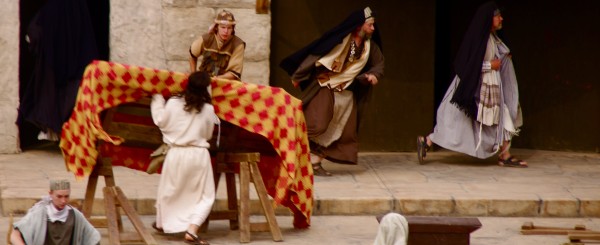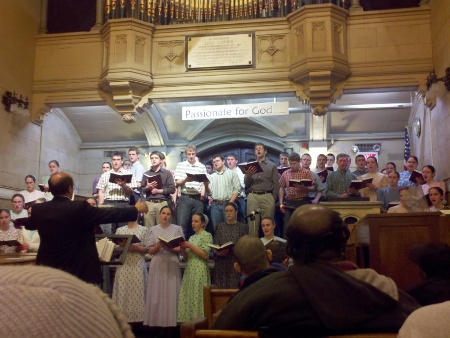Earlier this month, Charity Erickson wrote an article, “Peace Reformation = Humble Leaders” that offered some questions and challenges for neo-Anabaptists around leadership and the roots of this growing movement. The response, in the comments on her post and on social media, was cantankerous. I followed up with her to do an interview, the fifth in my Anabaptist camp followers series. My questions are in bold. Crossposted from As of Yet Untitled
 What does neo-Anabaptism mean to you?
What does neo-Anabaptism mean to you?
Charity: I understand neo-Anabaptism to be an ecumenical movement that is inspired and influenced by Anabaptist thought. This influence isn’t confined to traditional Anabaptist thought as expressed in documents like the Schleitheim Confession; it includes the critique of power that we get from post-modernism and post-colonialism. These critiques are not native to Anabaptist thought. In many ways, they are not native to Western thought. But they are good critiques; they are Spirit-guided, I think.
How did you first come across neo-Anabaptist thought and practice?
Charity: When I was 11–around 1996–I joined the Bible Quiz team at my Christian Missionary Alliance church. We memorized a lot of scripture; but we also had these t-shirts that we inherited from a group that had recently split off from our church to focus on their urban ministry in Minneapolis, which included communal living, serving those struggling with poverty, and fostering interfaith dialogue. The t-shirts were black with an anarchic kind-of symbol on the front, and the words, “Resistance is Futile.”
(more…)
TimN
October 26, 2013
Anabaptist Camp Followers, empire, neo-Anabaptism, Power, Privilege, Race, Sexism
Read more >
This is cross-posted from As of Yet Untitled
The last two months have seen a growing number of articles on John Howard Yoder’s sexual harassment and abuse of women (for a list of articles, see the Women in Learship Project’s timeline and annotated bibliography) led by Barbra Graber’s July 17 article on Our Stories Untold. Many of these pieces have been in conversation with Dr. Ruth Krall’s important book, The Elephants in God’s Living Room, Volume Three: The Mennonite Church and John Howard Yoder, Collected Essays, which I draw on heavily in this article. I especially recommend her sixth chapter, “John Howard Yoder, D. Theol. 1927-1997: Believer’s Church Theologian and Ordained Mennonite Clergyman,” which looks in detail at Yoder as a case study.
In joining this conversation, I’d like to look particularly at how systemic issues of power and privilege played out in the tiptoeing response of Mennonite church institutions and their leaders to Yoder’s persistent sexual harassment and sexual abuse of women. In her introduction, Krall succinctly names the many power layers of systemic privilege from which Yoder benefitted. He was a “clan-protected, powerful, tenured, white married male.” (Krall, 16) We have much to learn from looking at those layers.
The problem with sexual misconduct
In her introduction to the collection, Krall points out that the term “sexual misconduct,” which has been used to describe Yoder’s behavior, is unhelpful because it does not differentiate between consenting adultery and coercive, violent and dominating behaviors. (Krall, 6).
(more…)
TimN
September 10, 2013
Mennonite Church USA, Politics, Power, Sexism, Social justice
Read more >

Oh how I wish Jesus had set a better example!
Let’s be reasonable here. He should have proposed his prophetic action in consultation with the religious leadership far in advance of the Passover feasts. This would have reduced so much stress for the Pharisees and scribes.
He shouldn’t have made his case using sacred scriptures. Too risky, too radical, too much playing his religion card like he knew it all. Why did he have to bring Isaiah or Jeremiah into this, crazy activists claiming God’s house for foreigners, eunuchs and the like! One issue at a time now! How dare he come to the temple with an agenda!
He certainly should have worked within the structures to ensure no one would be offended, no one would risk the chance at dialogue due to untimely, unvetted mention of certain outcasts. Didn’t he know that if you want to include these people, you have to exclude those people.
He should have toned it down at least a little, no name-calling nor blocking pedestrian traffic in the temple. And what’s with the whip of cords!?
Read more and get involved over at overturningtables.org!
CharlettaE
July 1, 2013
activism, Allyhood, Anabaptism, antiracism, Current Events, Exclusion, Gender, Group Identity, Immigration, Indigenous, LGBTQ, Mennonite Church USA, Peace & Peacemaking, Polarization, Power, Privilege, Race, Social justice, Spiritual Life
Read more >
This multi-part post is the first in the Anabaptist Streams series here on Young Anabaptist Radicals, in which we’ll be looking at different streams of early Anabaptism and making connections with our own context. The series will feature different authors over the coming months and is loosely based on Rodney Sawatsky’s model of four streams of Anabaptism. It will feature different authors over the coming months, each looking at a different stream.
In this article (and two following) I’ll focus on the Davidites, a little known Anabaptist sect that had a tremendous impact on Menno Simons and the group that became the Mennonites, what Sawatsky identifies as the establishment stream. The Davidites were the followers of David Joris, an urban prophet responding to massive disruption of the traditional social fabric, what Ferdinand Tönnies called Gemeinschaft (Graham and Haidt, 376). Understanding Joris can help us understand Mennonites and how they became who they are today. I’ll be drawing heavily on Gary Waite’s David Joris and Dutch Anabaptism, 1524-1543.
 David Joris, painted between 1635 and 1665. From Wikipedia
David Joris, painted between 1635 and 1665. From Wikipedia
We’ll start by looking at how Joris established his authority as a leader. Anabaptists as a movement rejected traditional sources of authority, so the question of how to organize their own communities was constantly evolving.
(more…)
TimN
June 23, 2013
Anabaptism, Four Streams of Anabaptism Series, History, Power
Read more >
As Anabaptism emerged in 1525, opponents of this new movement described those who became a part of this movement as “radicals.” They even described it as “the Radical Reformation.” Why did they describe this movement as “radical”?
In one way it seems fitting. The early Anabaptists did not seek to reform the church but to restore it to the way of Jesus–the way in which the community of Jesus was gathered and was taught. This way meant taking the teachings and life of Jesus seriously; to live according to his example. For example, given that Jesus was the Prince of Peace, it was a call for his followers to live by this same peace. When Jesus taught to love one’s enemies, it was a call to not seek ways of killing someone. Jesus, the kingdom that he inaugurated, and his invitation to participate in this kingdom is radical. Therefore to live by his example would be very radical!
There were several particular reasons why the Anabaptists were described as “radicals” in the 16th century. One reason was that to follow in the ways of Jesus required one to live according to his example. Menno Simons wrote in 1539 that “Whosoever boasts that he is a Christian, the same must walk as Christ walked.” A follower would need to make a voluntary decision to follow the way of Jesus. Second, was the conviction that to follow Jesus, the Prince of Peace, meant also being people of peace. This meant practicing nonviolence even if confronted by violence. “Pacifism” is the word used to describe this path of discipleship. They believed that God’s shalom (peace) would not come through violence. Third, the ways of Jesus, his kingdom, and thus the ways of the community–the church–seeking to be faithful to Jesus and the kingdom would lead to practices that would conflict with the principalities and powers. The focus of these principalities and powers was not, and would not be, the pursuit of the kingdom of God. This becomes apparent in that “the powers” normally use a top-down, authoritarian form of ruler-ship and power, whereas the Anabaptist understanding of church assumes a bottom-up, servant attitude towards the other. Also, the state could not depend on these radicals to participate in the call to war and killing. This was revolutionary. The call of the disciple of Jesus was to follow his will even if that put them into conflict with the will and desire of the state.
(more…)
AndrewS
May 7, 2013
Anabaptism, Discipleship, Ethics, Peace & Peacemaking, Power, TheologyAnabaptism, gelassenheit, pacifism, peace, radical, Radical Reformation, self-surrender, shalom
Read more >
This piece by Rachel Halder is cross-posted from Our Stories Untold, a blog provoking conversation and allowing women and men to tell their stories about sexualized violence within religion, specifically the Mennonite Church.
“Most men in their lives will not commit sexual violence,
but most acts of sexual violence are committed by men.”
Joe Campbell from Calgary Communities Against Sexual Abuse

In order to end sexualized violence against women, children and men, we need men.
To end child abuse, domestic violence, verbal and physical abuse, we need men.
To end misogyny, we need to look to our young boys, teens, and husbands to assist in the fight for women’s rights. We need men.
It is when we see rape as only affecting the female victim that we’ve lost an important truth in the world. When we view the physical and psychological repercussions of abuse as damage only impacting the victim, we are missing a vital point. Rape and sexualized violence–whether it’s being committed against a man, a woman, or a child–destroys our collective humanity. It destroys our communities and institutions, even when we turn a blind eye or don’t admit that it’s there. Sexualized violence seeps into the cracks of our consciousness and it wiggles its way into our understanding of the world, gender roles, and where the blame should fall when such violent and horrible crimes are committed. This unawareness of rape is what allows rape culture to thrive. It’s what allows situations like Steubenville happen. And when we ignore it and act like we are separate or somehow different from these crimes, we are lost. (more…)
RachelH
February 12, 2013
activism, Power, Privilege, Rape, Sexismchild abuse, Christianity, Church, gendered violence, good men project, Our Stories Untold, Rape, religion, Sexual Abuse, sexual violence, Steubenville, violence against women, voices of men
Read more >
Hey y’all,
Jonathan Wilson-Hartgrove just wrote an article today, called “Nonviolence for White People” and invites your feedback: http://www.mennoworld.org/blog/2013/1/10/nonviolence-white-people/
This is a great discussion for young Anabaptist radicals, particularly white folks.
ST
January 10, 2013
activism, Allyhood, New Monasticism, Nonviolence, Power, Privilege, Race
Read more >
Cross-posted from As of Yet Untitled (with different introduction)

Over the years here on YAR, discussions about the differences between the approach of the (Old) Mennonite Conference (MC) and General Conference (GC) have cropped up now and again. This comment from AlanS from 2010 is probably one of the most insightful. For non-Mennonites or those who have joined in the last 12 years, these reference are mysterious. Nevertheless, for those of of us working for change in the Mennonite church, understanding these differences are critical. To that end, here is my interview with Lin Garber, the convener of Mennoneighbors and a writer and editor. Lin graduated from Goshen College in 1957 and is a member of The Mennonite Congregation of Boston.
Tim: Lin, in a comment on The Mennonite website* you discussed the differering approaches of General Conference (GC) and the “Old” Mennonite Church (MC) to Section III (“Clarification on some issues related to homosexuality and membership”) of Membership Guidelines for the formation of Mennonite Church USA (2001). For those who have never heard of the terms GC and MC, can you briefly explain some of the history?
Lin: Today’s Mennonite Church Canada (MC Canada) and Mennonite Church USA (MC USA) took their present forms around 2000 in what was termed a “transformation” (as opposed to discarded language like merger and integration). What had been the Mennonite Church, often informally and unofficially referred to as the “Old” Mennonites (MC), stemmed largely from 18th-century immigrants to North America with Swiss and south German origins. It had conferences in both the United States and Canada, a few of which had congregations on both sides of the border, but the bulk of its membership was in the United States.
What had been the General Conference Mennonite Church came out of a movement within the “Old” Mennonites of southeastern Pennsylvania in 1847 that in 1860 organized as the General Conference of the Mennonite Church of North America. A main stated goal of the group was to unite all Mennonites into one body. It grew slowly over the next dozen years as a few congregations decided to join it, but starting in 1874 its membership exploded with the influx of immigrants from central Europe and especially from southern Russia, mostly the Ukraine. The bulk of these immigrants were of Dutch-Prussian (i.e., north German) descent, and those cultural influences came to dominate. At the time of the “transformation” around 2000, the membership of the GC was roughly balanced between the United States and Canada, with the United States having a slight edge.
(more…)
TimN
July 26, 2012
LGBTQ, Mennonite Church USA, Power
Read more >
As the sun hovered at the horizon, I got into the big canoe with 20 people from Las Pavas. We were mostly men with a few woman and one young boy. We pulled away from the bank of the river and began motoring towards the sunset, racing against the light.

(more…)
TimN
June 25, 2012
Corporations, Peace & Peacemaking, Politics, Power
Read more >
It’s difficult to know where to begin reporting on the #Occupy Empire mini conference that took place at Eastern Mennonite Seminary back in April. Though the conference was short, there was nothing “mini” about the content lined up by the conference planners, Brian Gumm and Aaron Kauffman. Thus what I offer here is a reflection on the themes that stood out to me. Others might have noticed different threads woven throughout the weekend, or simply have been alert and listening carefully during those moments when I distracted by refilling my coffee mug. I won’t pretend to hit on every single presenter and every important theme that was brought up. This is simply what challenged me, and I’m grateful to have had the opportunity to attend the conference.
(more…)
MeghanF
June 1, 2012
Anabaptism, Poweranabaptists, empire, mission, occupy, Power
Read more >
Last Friday, the city of Philadelphia handed out eviction notices to Occupy Philadelphia, notifying the residents that they had to leave by Sunday at 5pm, or they would be removed.
While, I haven’t been a part of this movement, I’ve been observing them from the edges. And, when I heard about the eviction, I was anxious. I saw the UC Davis footage, I read stories about violent evictions in other cities–I was worried about Occupy Philadelphia.
The Interfaith Clergy group called on Philadelphia pastors to go to City Hall on Sunday night, to stand as a witness and reminder that we are called to the way of peace. So, my colleague and I headed downtown.
It was obvious that we were clergy–some people would walk by us, and thank us for coming, but mostly we were relegated to the edges of the event. We were marginalized, and that was ok. We were observers, not participants.
When the Eagles football game let out, we saw more movement around the Occupy Philadelphia encampment. Disappointed sports fans were coming up from the subway, and streaming into the square. Many were intoxicated. A few were very angry with the Occupiers.
One group of young men concerned me right away. I heard them making plans to pick a fight with the protestors, to get themselves on the news. They were convinced that they would be hometown heroes.
(more…)
AmyY
November 28, 2011
activism, Anabaptism, Church, Conscientious Objection, Emerging Church, Faith, Nonviolence, Peace & Peacemaking, poverty, Power, Tactics, Young Folks
Read more >

This month Malcom Gladwell had an article in the New Yorker looking at the legacy of Steve Jobs. His central thesis is that Jobs’ gift was not originality, but rather tweaking: the ability to take the inventions of others and refine and improve them dramatically. Gladwell points out that the iPod came out 5 years after the first digital music players and the iPhone more than a decade after the first smart phones hit the market.
Gladwell is building on the work of economists Ralf Meisenzahl and Joel Mokyr who used this lens to look at the industrial revolution in Britain. For example, they point out the importance of the many engineers who improved on Samuel Crompton’s original invention of the spinning mule. These “tweakers” dramatically improving its productivity through minor changes.
Likewise, Gladwell says, “Jobs’ sensibility was editorial, not inventive. His gift lay in taking what was in front of him–the tablet with stylus–and ruthlessly refining it.” Gladwell makes his point with many episodes from Walter Isaacson’s biography of Jobs. Job’s particular way of tweaking made him very difficult to get along with, even as he was dying of cancer:
At one point, the pulmonologist tried to put a mask over his face when he was deeply sedated… Jobs ripped it off and mumbled that he hated the design and refused to wear it. Though barely able to speak, he ordered them to bring five different options for the mask and he would pick a design he liked. . . . He also hated the oxygen monitor they put on his finger. He told them it was ugly and too complex.
(more…)
TimN
November 27, 2011
Anabaptism, History, Mennonite Church USA, Peace & Peacemaking, Power, Privilege
Read more >
Amtrak crosses the county carrying overnight passengers, strangers who engage each other as little or as much as they want. I overhear the social analysis of foreigners, business owners, union workers, environmentalists, activists and Amish. Wide seats, scenic cars, and café tables host a unique social atmosphere, literally a meeting in between places with a cross-section of the world.
Last night I returned from New York State via Amtrak, following a weekend of faith-based social justice fellowship with the Word and World mentoring program. I heard three young men relate their weekend experience of Occupy Wall Street in New York City. Computer speakers played Colbert’s speech at the White House Press Dinner. Elderly voices discussed political debates in Iowa, “Those politicians are all liars” … “Well that should not attract votes the way they argue.”
Tim spotted the chance for a window into the Occupy Wall Street (OWS) movement from its source in New York City. We invited the activists to the café car for an interview. Eli Fender (23), from Seattle joined the camp for two weeks. Robert Smith (20) and Riley O’Neil (20) both originally from Rogers Park in Chicago (small world) both visited the camp over the weekend.
Charletta: Tell us about the movement’s shape. What are some of the tools that are important at OWS?
Eli: There’s the people’s microphone, which a lot of people know about. There’s also working groups such as the facilitation working group who guides the General assembly. In democracy you worry about where power starts welling up. So I joined the facilitation group meeting.
(more…)
CharlettaE
October 24, 2011
activism, antiracism, communication, Corporations, Current Events, Economics, Environment, Leadership, Nonviolence, poverty, Power, Privilege, Wealth
Read more >
Since almost two months now I am working on a Palestinian farm surrounded by settlements – more on the project maybe in another article. Today I want to share with you an observation I have made about my relationship with the animals I am taking care of. All our animals have a very strong will for freedom and since it’s not only my job to feed and clean them, but also to lock them in their cages and repairing the fences, this will for freedom conflicts with my role.
But while the goats ram me with their head and the horses sometimes try to run away, or even kick me, our dogs have employed a different strategy:
They always break out of their cage either during lunch or dinner to protest the lack of food I am giving them and run around barking. So, I need to interrupt my meal and catch them. Now the strange thing happens. While sometimes they’ll run away, when I catch them, they always just lie numb on the ground and stretch their feet out towards me. They don’t try to bite me, they’re just lying there. I try to convince them by telling them it is my duty to lock them up and I’m sorry I can’t give them more food, but I can only give them as much food as possible.
No reaction.
Next, I pet them and promise them I’ll try to get extra food though I know there isn’t any.
No reaction. (more…)
Ben_jammin
October 23, 2011
Animals, Bias, Dumb Stuff., Israel, Military, Nonviolence, Palestine, Power, Stewardship, TacticsAnimals, Bias, Dumb Stuff., Israel, Military, Nonviolence, Palestine, Stewardship
Read more >

There’s a building boom on the Bowery these days. It’s been happening for a while, but the last couple years have witnessed an escalation in development, turning the neighborhood into a hip destination point.
Fifty years ago the Bowery was the largest skid row in the world. There were gin joints and flophouses on every block. That’s all gone now, thanks to the forces of gentrification. In their place are condos, art galleries and upscale eateries. Only one skid-row relic remains: the Bowery Mission.
Some of my earliest memories are of sitting behind the Mission’s pulpit in the 1960s, looking onto a sea of expectant faces while my father preached. In retrospect I realize the men behind those faces were awaiting the sermon’s conclusion so they could get their grub. (more…)
CharlieK
August 22, 2011
Anabaptism, Biographical, Change, Church, City, Civilization, Consumerism, culture, Current Events, Economics, Education, Ethics, Evangelism, Exclusion, God, Group Identity, History, Interfaith, Love, Mennonite Church USA, Mental health, Nonviolence, philosophy, Polarization, poverty, Power, Privilege, Race, Schism, Sex, Spiritual Life, Stewardship, Stories, The Bible, Theology, Tolerance, Tradition, Urban Ministry, Wealth
Read more >
 What does neo-Anabaptism mean to you?
What does neo-Anabaptism mean to you?
 David Joris, painted between 1635 and 1665. From
David Joris, painted between 1635 and 1665. From 



